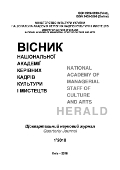ВИДОВИЩЕ ЯК СКЛАДОВА СУЧАСНОЇ КУЛЬТУРИ: ДО ПОСТАНОВКИ ПРОБЛЕМИ
DOI:
https://doi.org/10.32461/2226-3209.1.2018.160494Ключові слова:
масова культура, видовище, сучасна видовищна культура, масові театралізовані вистави, візуальність.Анотація
Мета роботи: систематизація існуючих праць щодо проблеми видовища, а також виявлення особливостей видовища в умовах сучасної культури. Методологія. Методологічною основою дослідження є загальнонаукові принципи систематизації та узагальнення, а також міжнауковий підхід, який дає змогу вивчити проблему з широ-ким залученням наукових доробків із різних галузей знання, зокрема філософії, культурології, мистецтвознавства та соціології культури. Наукова новизна полягає в обґрунтуванні думки щодо того, що видовище дає змогу об'єднати маси людей на ґрунті єдиної культурної традиції, долучити до вічних цінностей розрізнених індивідів. Висновки. Переважна більшість видовищ служить комерційним або соціально-політичним цілям, не сприяючи зростанню духовності. Однак сучасні реалії потребують того, щоб видовище відігравало важливу роль у підне-сенні і ствердженні духовності , підтримуючи традиції і цінності, сприяючи поновленню та відродженню культури. Сучасна видовищна культура, з одного боку, спрямована на емоційне і розважальне задоволення його учасників і глядачів, а з іншого можна стверджувати, що розвиток видовищної культури визначається і появою режисера, і використанням елементів театралізації та сучасних інноваційних медіа-технологій, розвиток яких певною мірою зумовлений розвитком видовищної культури. Багатофункціональність сучасного видовища спонукає до творчого пошуку фахівців різних галузей, залучених у сферу створення масових дійств, іноді виконує не лише розважаль-ну, а й виховну функцію, пізнавальну і навіть, арт-терапевтичну.
Посилання
Sight. Modern Dictionary of the Ukrainian Language: 65,000 words (2006), Kharkiv : School Publishing House, 112. [in Ukrainian].
Guyot, J.M. (1900). Art from the sociological point of view, St. Petersburg: Typography People's benefit [in Russian].
Davydov, A. A. (2014). "Spectacle" and "entertainment": to clarify concepts. Philosophy. Culturology: Bulletin of Nizhny Novgorod University named after N. Lobachevsky. Series: Social Sciences, 1(33), 135-140 [in Russian].
Logvinova, O.O. Trends in the transformation of theatrical genres and forms of modern spectacle culture. Retrieved from: http://www.visnik.org/pdf/v2014-07-17-logvinova.pdf [in Ukrainian].
Stanislavskaya, K.I. (2013). The artist and spectator: a view on the relationship in the modes of postmodern spectacular culture. Scientific Bulletin of the Kyiv National University of Theater, Cinema and Television named after. I. K. Karpenko-Karyi, 13, 180-189 [in Ukrainian].
Khrenov, N. A. Interaction of spectacular and visual forms in modern culture. Retrieved from: https://cyberleninka.ru/article/n/vzaimodeystvie-zrelischnyh-i-vizualnyh-form-v-sovremennoy-kulture [in Russian].
Chmil, G. P. (2013). Visualization of the real in the modern cultural space: Monograph, Kyiv: Institute of Cultural Studies, NAMU [in Ukrainian].
Shubina, I. B. (2005). Spectacle in culture. Extended abstract of candidate’s thesis. Rostov-on-Don [in Russian].
Видовище // Сучасний тлумачний словник української мови : 65 000 слів / За заг. ред. д-ра філол. на-ук, проф. В. В. Дубчинського. – Х. : ВД "ШКОЛА", 2006. С. 112.
Гюйо Ж. М. Искусство с социологической точки зрения / Жан Мари Гюйо, 1900, СПб. : Типография тов-ва "Народная польза" 462 с.
Давыдов А. А. "Зрелище" и "зрелищность": к прояснению понятий / А. А. Давыдов // Философия. Культурология : Вестник Нижегородского университета имен Н. Лобачевского. Серия : Социальные науки, 2014. № 1 (33). – С. 135-140.
Логвінова О. О. Тенденції трансформації театралізованих жанрів та форм сучасної видовищної куль-тури / О. О. Логвінова // [Електронний ресурс]. – Режим доступу : http://www.visnik.org/pdf/v2014-07-17-logvinova.pdf.
Станіславська К. І. Митець і глядач: погляд на взаємини у модусах постмодерністської видовищної культури / К. І. Станіславська // Науковий вісник Київського національного університету театру, кіно і телебачення ім. І. К. Карпенка-Карого. 2013. Вип. 13. С. 180-189.
Хренов Н. А. Взаимодействие зрелищных и визуальных форм в современной культуре / Н. А. Хренов[Электронный ресурс] – Режим доступа : https://cyberleninka.ru/article/n/vzaimodeystvie-zrelischnyh-i-vizualnyh-form-v-sovremennoy-kulture.
Чміль Г. П. Візуалізація реального в сучасному культурному просторі : Монографія / Чміль Г., Кораб-льова Н. – К. : Ін-т культурології НАМУ, 2013. – 256 с.
Шубина И. Б. Зрелище в культуре : автореф. дис. … канд. филос. наук : спец. 09.00.13 "Религиоведе-ние, философская антропология, философия культуры" / И. Б. Шубина. – Ростов-на-Дону, 2005. – 16 с.
##submission.downloads##
Опубліковано
Номер
Розділ
Ліцензія
Автори, які публікуються у цьому журналі, погоджуються з наступними умовами:
1. Автори залишають за собою право на авторство своєї роботи та передають журналу право першої публікації цієї роботи на умовах ліцензії Creative Commons Attribution License International CC-BY, котра дозволяє іншим особам вільно розповсюджувати опубліковану роботу з обов'язковим посиланням на авторів оригінальної роботи та першу публікацію роботи у цьому журналі.
2. Автори мають право укладати самостійні додаткові угоди щодо неексклюзивного розповсюдження роботи у тому вигляді, в якому вона була опублікована цим журналом (наприклад, розміщувати роботу в електронному сховищі установи або публікувати у складі монографії), за умови збереження посилання на першу публікацію роботи у цьому журналі.
3.Політика журналу дозволяє і заохочує розміщення авторами в мережі Інтернет (наприклад, у сховищах установ або на особистих веб-сайтах) рукопису роботи, як до подання цього рукопису до редакції, так і під час його редакційного опрацювання, оскільки це сприяє виникненню продуктивної наукової дискусії та позитивно позначається на оперативності та динаміці цитування опублікованої роботи.

